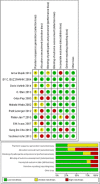The effects of total knee arthroplasty on knee proprioception of patients with knee osteoarthritis: a meta-analysis
- PMID: 35526039
- PMCID: PMC9077928
- DOI: 10.1186/s13018-022-03142-0
The effects of total knee arthroplasty on knee proprioception of patients with knee osteoarthritis: a meta-analysis
Abstract
Background: Studies have given some pieces of evidence for the effect of total knee arthroplasty (TKA) on knee proprioception of patients with knee osteoarthritis (KOA), but their results were conflicting. This review was performed to provide an updated evidence-based meta-analysis investigating the influence of TKA on knee proprioception.
Methods: The electronic databases including PubMed, Google Scholar, and the Cochrane Library were accessed from their inception to March 2020. Two reviewers identified the studies that met the selection criteria for this review. Information on study type, participants, follow-up time, and outcome measures was extracted. Methodological quality was independently assessed by two reviewers using the Cochrane Handbook 5.1.0. Eleven studies with 475 participants were included in the meta-analysis.
Results: The I2 index assessed the heterogeneity between studies. The results showed that the pooled standard mean difference of mean angle of error was - 0.58° (95% CI - 1 to - 0.16; P = 0.007; I2 = 69%), and the joint position sense of KOA patients was better after TKA surgery than that before surgery. Pooled standard mean difference of displacement of center of pressure (COP) was - 0.39 (95% CI - 0.72 to - 0.06; P = 0.02; I2 = 51%), and KOA patients had better static balance after TKA surgery than before surgery.
Conclusions: To conclude, no standardized comprehensive evaluation protocol presently exists though different assessment tools are available to measure proprioception. Contrasting results were found in the literature since some studies found that TKA improves proprioception in KOA patients, while others found no difference in proprioception. These differences are seen whether the proprioception was assessed by joint position sense (JPS), or it was indirectly assessed by static balance. However, the lack of sufficient data on the threshold to detect passive movement (TTDPM) and dynamic balance made it difficult to draw a conclusion about whether or not the sense of motion improved after surgery. The method for measuring and evaluating knee joint force sense is worth paying attention, which will make progress with knee proprioception on TKA patients.
Keywords: Balance; Knee osteoarthritis (KOA); Knee proprioception; Meta-analysis; Total knee arthroplasty (TKA).
© 2022. The Author(s).
Conflict of interest statement
The authors declare that they do not have any competing interests.
Figures








References
Publication types
MeSH terms
LinkOut - more resources
Full Text Sources
Medical
Miscellaneous

